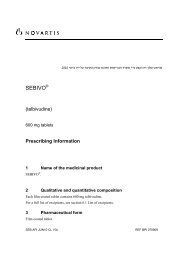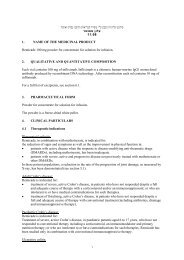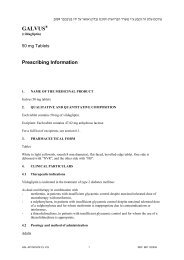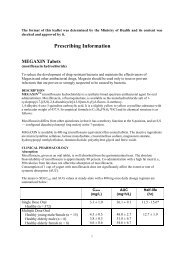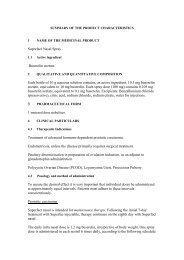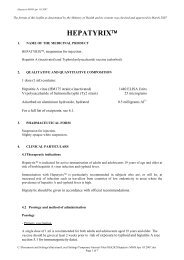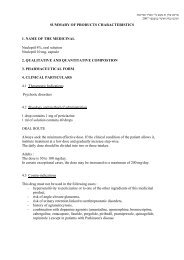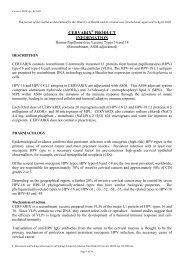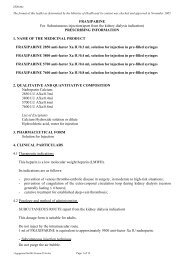Suprefact Depot 2 Months, implant for subcutaneous route Suprefact ...
Suprefact Depot 2 Months, implant for subcutaneous route Suprefact ...
Suprefact Depot 2 Months, implant for subcutaneous route Suprefact ...
Create successful ePaper yourself
Turn your PDF publications into a flip-book with our unique Google optimized e-Paper software.
SUMMARY OF THE PRODUCT CHARACTERISTICS<br />
1 NAME OF THE MEDICINAL PRODUCT<br />
<strong>Suprefact</strong> <strong>Depot</strong> 2 <strong>Months</strong>, <strong>implant</strong> <strong>for</strong> <strong>subcutaneous</strong> <strong>route</strong><br />
<strong>Suprefact</strong> <strong>Depot</strong> 3 <strong>Months</strong>, <strong>implant</strong> <strong>for</strong> <strong>subcutaneous</strong> <strong>route</strong><br />
2 QUALITATIVE AND QUANTITATIVE COMPOSITION<br />
<strong>Suprefact</strong> <strong>Depot</strong> 2 <strong>Months</strong>:<br />
Each pre-filled syringe of <strong>Suprefact</strong> <strong>Depot</strong> with two identical rods contains, as active<br />
ingredient, 6.6mg buserelin acetate, equivalent to 6.3mg buserelin.<br />
<strong>Suprefact</strong> <strong>Depot</strong>3 <strong>Months</strong>:<br />
Each pre-filled syringe of <strong>Suprefact</strong> <strong>Depot</strong> with three identical rods contains, as active<br />
ingredient, 9.9mg buserelin acetate, equivalent to 9.45mg buserelin.<br />
For excipients see 6.1.<br />
3 PHARMACEUTICAL FORM<br />
Implant<br />
Each <strong>implant</strong> consists of two/three creamy-coloured rods<br />
4 CLINICAL PARTICULARS<br />
4.1 Therapeutic Indications<br />
<strong>Suprefact</strong> <strong>Depot</strong> is used <strong>for</strong> the treatment of advanced hormone-dependent prostatic<br />
carcinoma.<br />
However, <strong>Suprefact</strong> <strong>Depot</strong> is not indicated after bilateral orchiectomy as there would be no<br />
further reduction in testosterone levels.<br />
4.2 Posology and method of administration<br />
<strong>Suprefact</strong> <strong>Depot</strong> is intended <strong>for</strong> the long-term treatment of advanced prostatic carcinoma.<br />
It is recommended that administration of an anti-androgen is started as adjunctive therapy<br />
about 5 days be<strong>for</strong>e starting <strong>Suprefact</strong> <strong>Depot</strong> (see also "Special warnings and precautions <strong>for</strong><br />
use").<br />
Be<strong>for</strong>e injection, a local anaesthetic may be given.<br />
<strong>Suprefact</strong> <strong>Depot</strong> 2 <strong>Months</strong>:<br />
The contents of the syringe (two <strong>implant</strong> rods, equivalent to 6.3mg buserelin) are injected<br />
<strong>subcutaneous</strong>ly into the abdominal wall every two months (see “Instruction <strong>for</strong> use and<br />
handling”).<br />
The two month interval between injections may, however, occasionally be extended by a few<br />
days.<br />
דרשמ י"<br />
ע עבקנ הז ןולע טמרופ<br />
רשואו קדבנ ונכותו תואירבה<br />
2006 רבמטפסב
<strong>Suprefact</strong> <strong>Depot</strong> 3 <strong>Months</strong>:<br />
The contents of the syringe (three <strong>implant</strong> rods, equivalent to 9.45mg buserelin) are injected<br />
<strong>subcutaneous</strong>ly into the abdominal wall every three months (see “Instruction <strong>for</strong> use and<br />
handling”).<br />
The three-month interval between injections may, however, occasionally be extended by up to<br />
three weeks.<br />
4.3 Contraindications<br />
<strong>Suprefact</strong> <strong>Depot</strong> must not be administered to patients with hypersensitivity to buserelin,<br />
LHRH analogues or to any of the ingredients of <strong>Suprefact</strong> <strong>Depot</strong>.<br />
After surgical removal of the testes, no further reduction of testosterone levels by <strong>Suprefact</strong><br />
<strong>Depot</strong> can be expected.<br />
<strong>Suprefact</strong> should not be used if the tumour is found to be insensitive to hormone manipulation<br />
or after surgical removal of the testes<br />
4.4 Special warnings and special precautions <strong>for</strong> use<br />
It is recommended that administration of an anti-androgen is started as adjunctive therapy<br />
about 5 days be<strong>for</strong>e starting <strong>Suprefact</strong> <strong>Depot</strong>. This supplementary treatment must be<br />
continued in parallel with buserelin therapy <strong>for</strong> 3 – 4 weeks.<br />
In patients with known metastases, e.g. of the spinal column, this adjunctive therapy with an<br />
anti-androgen is essential to prevent initial complications such as spinal compression and<br />
paralysis arising from a transient activation of the tumour and its metastases (see also<br />
“Undesirable effects”).<br />
The response to treatment can be evaluated by measuring the serum levels of prostate-specific<br />
antigen (PSA) and testosterone. The testosterone levels increase at the start of treatment and<br />
then decrease during a period of two weeks. After 2 - 4 weeks the testosterone levels have<br />
decreased to a castration level. Absence of clinical improvement or of changes in PSA in the<br />
face of adequate testosterone suppression is diagnostic of hormone-insensitivity of the<br />
tumour.<br />
Patients with known metastases of the spinal column or those at risk of neurological<br />
complications or urinary obstruction should be closely monitored during the first weeks of<br />
therapy, if start of treatment is not accompanied by concomitant anti-androgen administration.<br />
In patients with hypertension, regular monitoring of blood pressure is recommended (risk of<br />
deterioration of blood pressure control).<br />
In diabetic patients it is recommended that blood glucose levels are checked regularly (risk of<br />
deterioration of metabolic control).<br />
Patients with a history of depression must be monitored carefully and treated if necessary<br />
(risk of recurrence or worsening of depression).<br />
4.5 Interaction with other medicinal products and other <strong>for</strong>ms of interaction<br />
During treatment with <strong>Suprefact</strong>, the effect of antidiabetic agents may be attenuated
4.6 Use during pregnancy and lactation<br />
<strong>Suprefact</strong> <strong>Depot</strong> must not be administered in women.<br />
4.7 Effects on ability to drive and use machines<br />
Certain adverse effects (e.g. dizziness) may impair the patient’s ability to concentrate and<br />
react, and, there<strong>for</strong>e, constitute a risk in situations where these abilities are of special<br />
importance (e.g. operating a vehicle or machinery or in similar situations).<br />
4.8 Undesirable effects<br />
At the beginning of the treatment, a rise in the serum testosterone level usually develops and<br />
may lead to temporary activation of the tumour with secondary reactions such as:<br />
- occurrence or exacerbation of bone pain in patients with metastases . In very rare cases<br />
slight, transient increase in tumor pain.<br />
- signs of neurologic deficit due to tumour compression with e.g. muscle weakness in the<br />
legs<br />
- impaired urinary flow, hydronephrosis or lymphostasis<br />
- thrombosis with pulmonary embolism<br />
These reactions can be largely avoided when an anti-androgen is given concomitantly in the<br />
initial phase of buserelin treatment (see also “Special warnings and precautions <strong>for</strong> use”).<br />
Frequencies are defined as: very common (>1/10); common (>1/100,1/1,000, 1/10,000,
Nervous system disorders:<br />
Common: headache<br />
Uncommon: drowsiness, dizziness<br />
Rare: sleep disturbances, disturbances in memory and concentration<br />
Very rare: tinnitus, hearing disorders. In isolated cases, paraesthesia has been observed with<br />
other presentations of buserelin.<br />
Eye disorders:<br />
Very rare: impaired vision (e.g. blurred vision), and a feeling of pressure behind the eyes<br />
Cardiac disorders:<br />
Rare: palpitations<br />
Vascular disorders:<br />
Common: Flush<br />
Rare: increase in blood pressure levels in patients with hypertension<br />
Gastrointestinal disorders:<br />
Uncommon: constipation<br />
Rare: Nausea, vomiting, diarrhoea<br />
Cutaneous disorders:<br />
Rare: increase or decrease in scalp or body hair<br />
Musculoskeletal disorders:<br />
Very rare: musculoskeletal discom<strong>for</strong>t and pain.<br />
The use of LHRH-agonists may be associated with decreased bone density and may lead to<br />
osteoporosis and an increased risk of bone fracture. The risk of skeletal fracture increases with the<br />
duration of therapy.<br />
Reproductive system disorders:<br />
Common: impotence, atrophy of the testes<br />
Uncommon: Gynaecomastia (painless)<br />
General disorders and administration site reactions:<br />
Common: pain or other local reactions (e.g. reddening, swelling) at the injection site.<br />
Uncommon: oedema (mild) round the ankles and lower parts of the legs, tiredness<br />
Very rare: deterioration in general well-being<br />
Investigations:<br />
Uncommon: increase in liver enzyme levels (e.g. transaminases), increase or decrease in<br />
weight.<br />
Rare: increase or decrease in blood lipids, increase in serum bilirubin<br />
Very rare: reduction in glucose tolerance (which in diabetic patients may lead to a<br />
deterioration of metabolic control),<br />
Most of the effects listed above are directly or indirectly related to the suppression of<br />
testosterone by buserelin (symptoms of androgen deficiency).
4.9 Overdose<br />
Intoxication with buserelin has so far not been observed. The effects reported with buserelin<br />
overdose do not differ from undesirable effects noted under normal use. Therapy <strong>for</strong><br />
overdose, if necessary, is directed to the symptoms.<br />
5 PHARMACOLOGICAL PROPERTIES<br />
5.1 Pharmacodynamic properties<br />
Pharmacotherapeutic group: ATC code: L02AE01<br />
Buserelin is a highly active analogue of the natural gonadotropin-releasing hormone<br />
(gonadorelin; GnRH, LHRH). The initial pharmacological effect of buserelin is to stimulate<br />
gonadotropin release and testosterone secretion. This is followed by a progressive decrease in<br />
testosterone into the castrate range.<br />
While gonadotropin release is inhibited during continued treatment with buserelin, the<br />
secretion of the other pituitary hormones (growth hormone, prolactin, ACTH, TSH) is not<br />
directly influenced. The secretion of adrenal steroids remains unchanged.<br />
In terms of removing testosterone stimulation of tumour tissue, buserelin is as effective as<br />
orchiectomy in the treatment of prostatic carcinoma.<br />
5.2 Pharmacokinetic properties<br />
The release of buserelin from the <strong>implant</strong> is controlled by degradation of the polymer matrix.<br />
The release profile is biphasic; the initial release (tmax
6 PHARMACEUTICAL PARTICULARS<br />
6.1 List of excipients<br />
Poly (D,L-lactide-co-glycolide)<br />
6.2 Special precautions <strong>for</strong> storage<br />
Store at room temperature (below + 25 0 C).<br />
6.3 Nature and content of container<br />
<strong>Suprefact</strong> <strong>Depot</strong> 2 <strong>Months</strong>:<br />
1 Pre-filled syringe containing an <strong>implant</strong> consisting of two rods in a disposable applicator.<br />
<strong>Suprefact</strong> <strong>Depot</strong> 3 <strong>Months</strong>:<br />
1 Pre-filled syringe containing an <strong>implant</strong> consisting of three rods in a disposable applicator.<br />
6.4 Instructions <strong>for</strong> use and handling, and disposal (if appropriate)<br />
Please note: To prevent the <strong>implant</strong> rods from falling out of the injection needle, hold the<br />
applicator in a vertical position until immediately prior to puncture, with the needle pointing<br />
upwards.<br />
A: Needle<br />
B: Protective cap of needle<br />
C: Plunger<br />
D: Implant<br />
E: Protective cap of plunger<br />
1. After opening the pack and removing the applicator from the wrapping, check that the<br />
<strong>implant</strong>s are located in the window of the handle (D). If necessary, tap the protective cap<br />
on the needle (B) lightly with the finger to reposition them in the window.
2. Disinfect the injection site in the area of the lateral abdominal wall. Then, after removing<br />
the protective case from the plunger (E), remove the protective cap from the injection<br />
needle (B).<br />
3. Lift a fold of skin, and insert the needle approx. 3 cm into the <strong>subcutaneous</strong> tissue, holding<br />
the applicator immediately prior to puncture in a horizontal position or with the tip of the<br />
needle pointed slightly upwards. Withdraw the applicator about 1 to 2 cm prior to injection<br />
of the <strong>implant</strong>s.<br />
4. Fully depressing the plunger (C), inject the <strong>implant</strong>s into the <strong>subcutaneous</strong> tissue.<br />
Compress the puncture channel while withdrawing the needle, so that the <strong>implant</strong>s are<br />
retained in the tissue.<br />
5. To make certain that the <strong>implant</strong>s have been injected check the tip of the plunger to see if it<br />
is visible at the tip of the needle.<br />
Manufacturer: Sanofi-Aventis, Germany.<br />
License Holder : sanofi-aventis Israel ltd. POB 8090 , Netanya 42504



